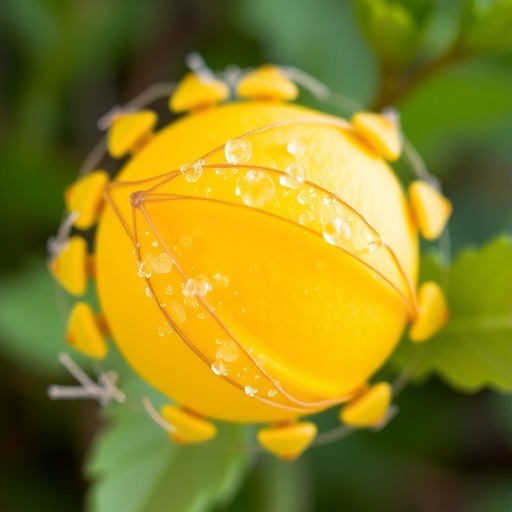In a groundbreaking study set to redefine the realm of environmental remediation, a team of researchers led by T.S. Dwivedi, S.J. Borah, and A. Gupta have developed a novel method for the removal of cationic dyes from wastewater. Their innovative approach revolves around the use of alginate encapsulated fluorescent carbon-core nanoparticles derived from the flowers of the Azadirachta indica plant, more commonly known as the neem tree. This fascinating research is poised to make significant strides in addressing the global challenge of dye pollution, particularly in textile industries where vast amounts of harmful chemicals are often released into waterways.
The fluorescence properties of the carbon-core nanoparticles represent a breakthrough in their application and functionality. Traditional methods of treating dye-laden wastewater often fall short, leading to environmental degradation and health hazards. In stark contrast, the fluorescent carbon-core nanoparticles offer a twofold advantage: not only do they effectively adsorb cationic dyes, but their fluorescent nature enables real-time monitoring of the efficacy of the treatment process. This unique feature could revolutionize how we approach wastewater management, providing an immediate visual feedback mechanism.
Drawing from the rich chemical makeup of the Azadirachta indica, the researchers utilized flowers from this remarkable tree to create nanoparticles that are both biodegradable and eco-friendly. The encapsulation in alginate, a natural polysaccharide derived from brown seaweeds, not only stabilizes the nanoparticles but enhances their adsorption capabilities. This clever use of organic materials underscores a growing trend in green chemistry, emphasizing the utilization of natural resources in constructing effective solutions to pressing environmental issues.
The creation of these carbon-core nanoparticles involved a precise and controlled process, ensuring that their size and shape were optimized for maximum interaction with dye molecules. The researchers employed sophisticated techniques to characterize the nanoparticles, employing methods such as transmission electron microscopy (TEM) and Fourier transform infrared spectroscopy (FTIR). Such thorough characterization is vital in confirming the structure and functionality of the synthesized nanoparticles, thereby bolstering their credibility as a viable solution for wastewater purification.
As awareness of sustainable practices continues to rise globally, the demand for efficient and reliable wastewater treatment solutions has never been greater. The conventional chemical methods often utilized in dye removal processes can lead to additional pollution, creating a paradox that environmental scientists and chemists seek to unravel. In this context, the use of biodegradable, plant-based nanoparticles presents a refreshing alternative that aligns with sustainability goals.
Field tests conducted by the research team demonstrated the remarkable efficiency of the alginate encapsulated nanoparticles in removing a variety of cationic dyes from aqueous solutions. The experiments revealed that the nanoparticles could achieve a near-complete removal rate under optimized conditions. This exceptional performance showcases the potential for these innovative solutions to be employed in real-world applications, from industrial wastewater treatment plants to smaller-scale operations.
Moreover, the economic implications of their findings are promising. The sourcing of raw materials from the neem tree—an agricultural product widely cultivated in many regions—means that the cost of producing these nanoparticles could be kept relatively low, making this method accessible to industries that may not have the financial means to implement more sophisticated technologies. This accessibility is essential if we are to achieve widespread adoption of effective wastewater treatment solutions.
The research does not merely highlight the creation of an innovative material; it opens avenues for further studies into other plant-derived nanoparticles that may hold similar characteristics. The concept of harnessing the natural properties of various botanical sources can lead to an explosion of new, environmentally sensitive technologies that can address a multitude of pollution challenges, thus contributing to the broader goals of sustainable development.
As the study expands beyond the laboratory, potential collaborations with industries currently grappling with dye pollution could further validate the practical applications of these findings. By working alongside textile manufacturers and other sector stakeholders, the research team can facilitate the transition from lab results to real-world impact, thereby ensuring that the innovative solutions they propose are both practical and effective in maintaining environmental integrity.
The societal impact of this research is significant, as exposure to industrial dyes is linked to various health risks, including skin irritations and other chronic conditions. By mitigating the pollution associated with dye production and processing, the researchers not only contribute to environmental cleanliness but also advocate for public health reforms.
As the world grapples with the realities of climate change and environmental decay, studies like this one remind us of the ingenuity present within our natural ecosystems. The neem tree’s consistent role as a source of medicinal and practical value underscores a vital message: solutions to combating today’s challenges may often lie hidden within our environment, waiting to be explored.
In summary, the innovative work by Dwivedi and his colleagues represents a significant leap forward in the search for effective and sustainable solutions to wastewater treatment. The synthesis of alginate encapsulated fluorescent carbon-core nanoparticles from Azadirachta indica flowers not only addresses the pressing issue of dye pollution but also exemplifies the potential of green alternatives in industrial applications. As this research paves the way for further exploration and real-world implementation, it stands as a testament to the important intersection of technology, science, and nature in safeguarding our environment for future generations.
Subject of Research: Development of biodegradable nanoparticles for dye removal.
Article Title: Alginate encapsulated fluorescent carbon-core regenerative Azadirachta indica flower-derived nanoparticles for efficient cationic dyes removal.
Article References:
Dwivedi, T.S., Borah, S.J., Gupta, A. et al. Alginate encapsulated fluorescent carbon-core regenerative Azadirachta indica flower-derived nanoparticles for efficient cationic dyes removal.
Environ Sci Pollut Res (2025). https://doi.org/10.1007/s11356-025-37119-3
Image Credits: AI Generated
DOI: https://doi.org/10.1007/s11356-025-37119-3
Keywords: Wastewater treatment, biodegradable nanoparticles, Azadirachta indica, cationic dye removal, green chemistry.




